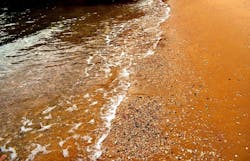Brewing Company Uses Spent Grain to Tackle Red Tide
Darwin Brewing Company is using spent grain, the byproduct of making beer, to tackle Red Tide.
According to Blue Hellenga, Darwin’s head brewer, some of the brewery’s spent grain has gone to the Mote Marine Lab.
Researchers at the lab are trying to find ways to overcome the Red Tide that impacts Florida’s Gulf Coast, reported Tampa Bay Times. The researchers believe the spent grains could hold molecules that stunt algal blooms.
After conducting early tests, the researchers found that the kind of molecules that exist in spent grain have killed small amounts of the organism in Red Tide within a few hours, according to Vince Lovko, a staff scientist at Mote. The molecules, also known as flavonoids, essentially suppress growth of Karenia brevis, the microorganism behind Red Tide, said researcher Allen Place, a professor in the University of Maryland’s Institute for Marine and Environmental Technology.
If the grain indeed is effective, whole grains would not be dumped straight into the water. Instead, the grain would be used to extract flavonoids and possibly some acids, which would then get mixed with Red Tide. The barley on its own contains compounds and nutrients that could hurt the environment or further fuel a bloom.
Researchers hope beer byproducts offer a stable, cheap source of the material.
“If you look at all the microbreweries in the U.S., the amount of spent grain that is made is ridiculously large,” said Place.
Darwin produces about 5,500 pounds of spent grain in a typical week, reported Tampa Bay Times.
So far this year, Florida has not suffered a big Red Tide, according to weekly monitoring from the state Fish and Wildlife Conservation Commission.
Mote is working with several research partners and approximately one million dollars in funding to understand Red Tide.
The grain study originated at the University of Maryland, where Place’s lab looked at an algal bloom in the lake of a local Girl Scout camp. Scientists threw in bales of barley straw, which rotted and released molecules.
The compounds have also shown potential to knock down parts of blue-green algae, added Armstrong.
